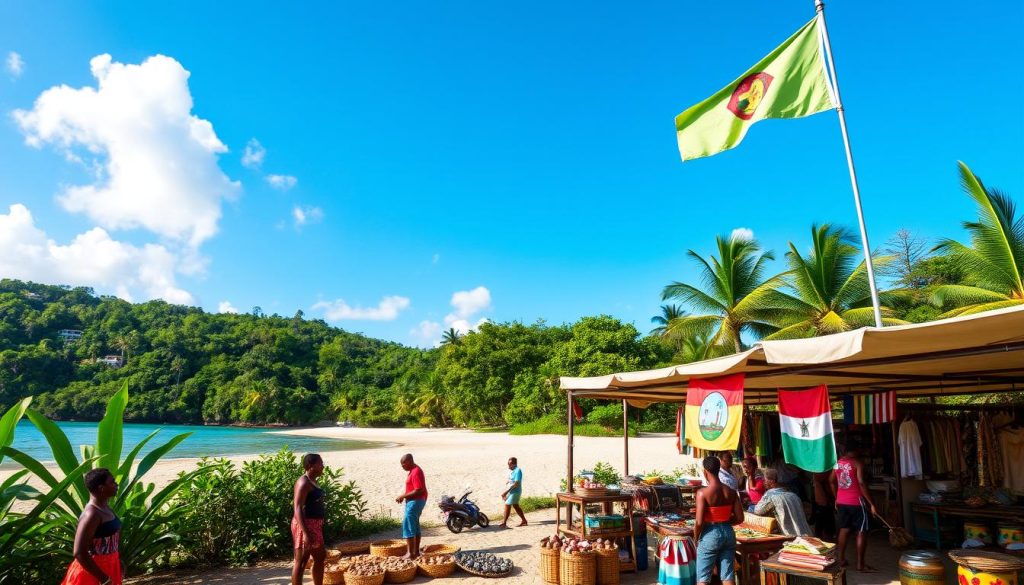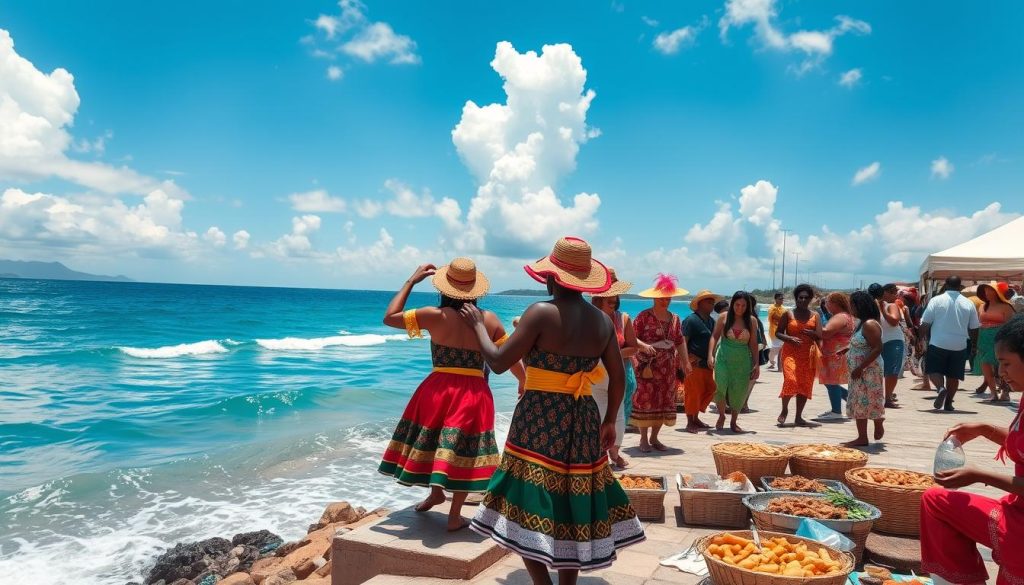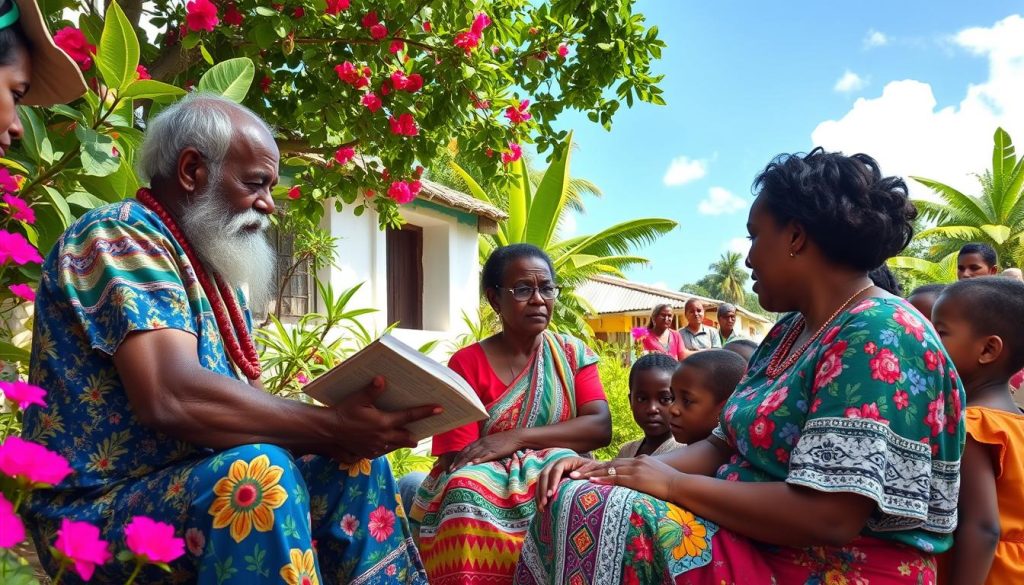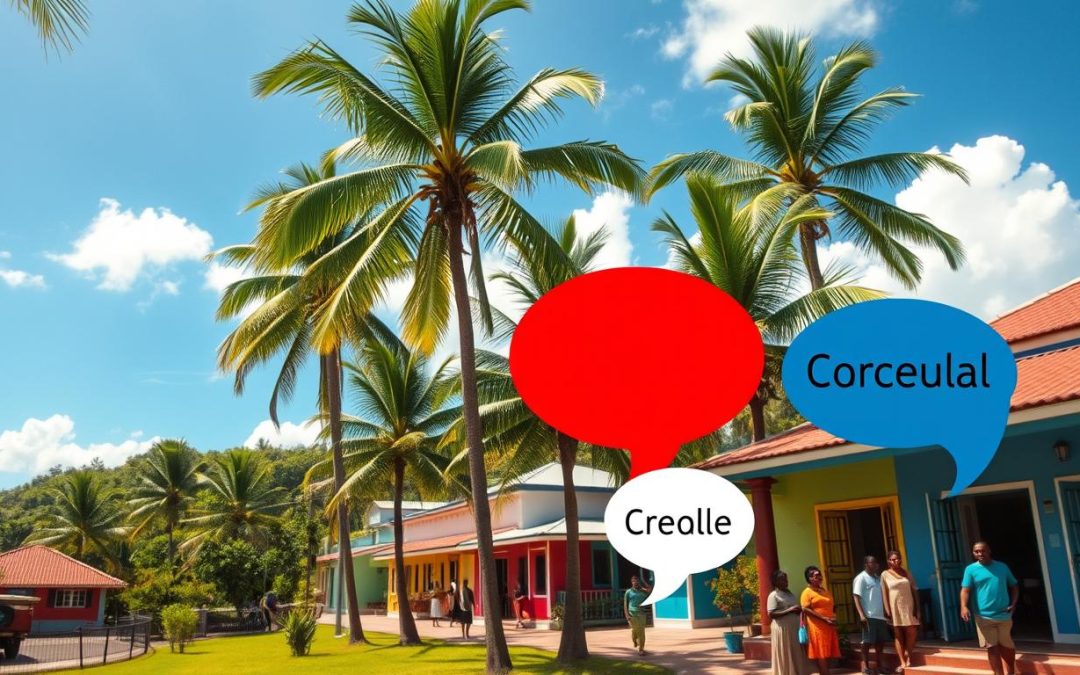Have you ever thought about how a small Caribbean nation handles its language mix with just 91,295 people? Antigua and Barbuda shows a unique mix of languages, beyond just English.
In this Caribbean paradise, language is more than talking—it shows the country’s history and culture. English is the official language, but the real story is in the diverse languages found here.
From Saint John’s streets to Barbuda’s shores, you’ll find a mix of languages. This blend includes official languages, Caribbean languages, and those from immigrants. It creates a special way of communicating.
Key Takeaways
- English is the official language of Antigua and Barbuda
- The nation hosts a diverse linguistic environment
- Around 150,000 native speakers use Caribbean Creole
- Immigrant languages significantly contribute to linguistic diversity
- Language reflects the country’s rich cultural heritage
Historical Language Development in Antigua and Barbuda
The story of language in Antigua and Barbuda is full of cultural mix-ups and big changes. It shows how languages changed over time, from the first people to the current mix of languages.
Indigenous Languages and Early Influences
Before Europeans came, the islands were home to the Arawak and Carib people. They had their own languages, which would soon face big changes.
- The Carib population initially numbered around 5,000
- By 1730, their numbers dramatically reduced to approximately 400
- Christopher Columbus first visited the islands in 1493
Impact of British Colonization
The arrival of the British changed the language scene in Antigua and Barbuda a lot. English settlers came in 1632, bringing their language and culture. This had a lasting effect on the Creole languages spoken today.
“Language is the road map of a culture. It tells you where its people come from and where they are going.” – Rita Mae Brown
Post-Independence Language Evolution
The plantation era (1705-1834) saw the rise of Creole languages. This happened when Europeans and Africans mixed, creating Antiguan Creole. It’s a lively mix of cultures.
| Historical Period | Linguistic Characteristics |
|---|---|
| Pre-Plantation (1646-1705) | Indigenous languages dominant |
| Plantation Era (1705-1834) | Emergence of Creole languages |
| Post-Emancipation (1834-1964) | Linguistic diversity expanding |
| Independence Era (1981-Present) | Creole languages culturally celebrated |
Today, the language policies and cultural practices in Antigua and Barbuda show this rich history. They highlight how language changes through social interactions.
English as the Official Language
In Antigua and Barbuda, English is a key part of who they are and how they talk to each other. After becoming independent in 1981, they kept English as their official language. This shows their strong ties to history and culture.

The English language in this Caribbean nation has a complex story. With about 91,295 people, English is vital for:
- Government communication
- Educational instruction
- Business transactions
- Legal documentation
Multilingualism is important in Antigua and Barbuda’s schools. English helps everyone communicate clearly. It also keeps the Caribbean’s rich language diversity alive.
“Language is the road map of a culture. It tells you where its people come from and where they are going.” – Rita Mae Brown
The country’s language policy makes sure English is useful everywhere. It helps locals talk to each other and connect with the world. This is especially true for the Commonwealth of Nations.
| Language Aspect | Description |
|---|---|
| Official Status | Primary official language since 1981 |
| Educational Use | Primary medium of instruction |
| Government Communication | Exclusively used in official documents |
| International Relations | Facilitates diplomatic and economic interactions |
English in Antigua and Barbuda is more than just a way to talk. It shows their history and cultural strength.
Antigua and Barbuda Creole English: The People’s Voice
The vibrant Caribbean languages of Antigua and Barbuda tell a rich story. They show cultural resilience and linguistic creativity. Creole languages are powerful expressions of identity, connecting generations through a unique linguistic landscape.
Linguists see the Creole English of Antigua and Barbuda as a deep communication system. It has deep historical roots. This dynamic language is more than words; it’s the cultural spirit of the islands.
Origins and Cultural Roots
Creole languages came from complex historical interactions. In Antigua and Barbuda, this journey reflects enslaved West African experiences. They created a communication method that went beyond oppressive systems.
- Approximately 150,000 native speakers
- Derived from multiple linguistic influences
- Reflects historical resistance and adaptation
Unique Linguistic Characteristics
The Antiguan Creole English has its own grammar and pronunciation. You might hear rhythmic variations, shortened words, and expressive intonations. These capture the islands’ cultural nuances.
“Language is the roadmap of a culture. It tells you where its people come from and where they are going.” – Rita Mae Brown
Social Significance
In language education and daily communication, Creole is a powerful marker of community identity. While English is official, Creole connects Antiguans through shared cultural experiences. It preserves historical narratives and social bonds.
Understanding Antigua and Barbuda’s Creole English opens a window into their rich cultural tapestry. It celebrates linguistic diversity and historical resilience.
Linguistic Diversity in Modern Antigua and Barbuda
Antigua and Barbuda is a vibrant mix of languages, showing its rich culture. The islands’ languages tell stories of migration, interaction, and cultural exchange. This makes their linguistic landscape unique.

The language scene in Antigua and Barbuda is interesting. English is the official language, but the islands are also home to many Caribbean and immigrant languages. Spanish is the most common immigrant language, thanks to people from the Dominican Republic who came since 1981.
“Language is the roadmap of a culture. It tells you where its people come from and where they are going.” – Rita Mae Brown
- Spanish speakers make up a big part of the linguistic community.
- Immigrants from the Dominican Republic have greatly added to the language mix.
- Caribbean languages are always changing.
To really understand Antigua and Barbuda’s languages, we need to look beyond numbers. The islands are a place where languages meet, mix, and create new ways to communicate.
| Language | Percentage of Speakers | Origin |
|---|---|---|
| English | 90% | Official Language |
| Spanish | 6% | Immigrant Community |
| Antiguan Creole | 4% | Local Variation |
The language scene is always changing, showing how Caribbean cultures are dynamic. Antigua and Barbuda’s love for language diversity shows their openness to cultural exchange and understanding.
Spanish Language Presence and Impact
The arrival of Spanish-speaking immigrants has changed Antigua and Barbuda’s language scene. You’ll see how Spanish has become part of the island’s culture. This has created a rich mix of languages and cultures.
Dominican Republic Immigration
Since 1981, many from the Dominican Republic have moved to Antigua and Barbuda. Here’s what the numbers show:
- 1,201 work permits given to Dominicans from 1997 to 2002
- There are between 3,000 to 10,000 Spanish speakers now
- More work permits are given to Caribbean immigrants than others
Government Response and Services
The government has taken steps to help the growing Spanish-speaking community. They’ve started Spanish programs in four schools. This shows their effort to include everyone.
“Language is the roadmap of a culture. It tells you where its people come from and where they are going.” – Rita Mae Brown
Cultural Integration
Integrating cultures is both hard and rewarding for Spanish in Antigua and Barbuda. But, there’s a trend. English is becoming more common, especially among the second generation.
| Language Metrics | Statistical Insights |
|---|---|
| Spanish Language Programs | 4 Urban Primary Schools |
| Estimated Spanish Speakers | 3,000 – 10,000 |
| Work Permits (1997-2002) | 1,201 Dominican Nationals |
The Spanish language is changing in Antigua and Barbuda. It shows how languages and cultures are always evolving in this lively Caribbean nation.
Portuguese Speaking Community

In Antigua and Barbuda, the Portuguese-speaking community adds a special touch to the country’s mix of languages. This group, though small, brings a lot of cultural richness to the islands. It shows how diverse the Caribbean’s languages can be.
The Portuguese language has been in Antigua and Barbuda since the mid-1800s. About 1,200 people speak Portuguese here, adding to the country’s language variety.
“Language is the road map of a culture. It tells you where its people come from and where they are going.” – Rita Mae Brown
- Historical immigration period: 1847-1852
- Total Portuguese immigrants: Approximately 2,500
- Current Portuguese speaker population: Around 1,200
- Percentage of total population: 0.2%
The Portuguese community in Antigua and Barbuda shows the trend of multilingualism in the Caribbean. Even though English is the official language, Portuguese speakers keep their culture alive. They do this through community ties and keeping their language alive.
| Language Characteristic | Details |
|---|---|
| Language Origin | Portuguese immigrants from mid-19th century |
| Current Speaker Population | Approximately 1,200 |
| Cultural Significance | Contributes to linguistic diversity |
Even though Portuguese is not the main language, it’s still very important in Antigua and Barbuda’s culture. The community’s efforts to keep their language alive show how vital it is to hold onto our cultural heritage in today’s world.
The Role of Arabic and Other Minority Languages
Antigua and Barbuda’s language scene is more than just a few main languages. It’s a colorful mix of many languages, with Arabic being a key part. This shows the country’s rich cultural diversity.
North Levantine Arabic Speakers
In the 20th century, people from the Middle East came to Antigua and Barbuda. Now, about 400 people speak North Levantine Arabic. They add a special touch to the country’s cultural mix.
- Estimated Arabic speakers: 400 individuals
- Primary origin: Middle Eastern immigration
- Language classification: North Levantine Arabic dialect
Cultural Contributions
Arabic speakers have made a big impact on Antigua and Barbuda. They bring their own language and culture, showing the country’s welcoming spirit. This diversity makes the country richer.
“Language is the roadmap of a culture. It tells you where its people come from and where they are going.” – Rita Mae Brown
| Language Group | Approximate Speakers | Cultural Impact |
|---|---|---|
| North Levantine Arabic | 400 | Cultural exchange and diversity |
Learning about these minority languages helps us see the full picture of Antigua and Barbuda’s language scene. It shows how different languages work together to create a vibrant culture.
Language Education and Policy
Language education in Antigua and Barbuda is complex. It focuses on multilingualism and linguistic development. The system makes English the main teaching language. This helps students learn well for both local and global communication.
The country’s language policies have several key strategies:
- Standardized English instruction across all educational levels
- Recognition of Antiguan Creole as a cultural linguistic resource
- Strategic introduction of additional language programs
In 2001, the Ministry of Education started a Spanish program in public schools. This was for schools with many Hispanic students. It shows the country’s effort to adjust education to demographic changes.
| Language Policy Component | Key Characteristics |
|---|---|
| Primary Instruction Language | Standard English |
| Secondary Language Program | Spanish in select schools |
| Cultural Language Recognition | Antiguan Creole preservation |
Understanding language education in Antigua and Barbuda shows a detailed approach. It keeps English as the main language but values linguistic diversity and cultural expression.
Language is not just a communication tool, but a bridge connecting cultural identities and global opportunities.
The challenge is to keep English skills high while also protecting local languages. This ensures students are ready for both local and international settings.
Sociolinguistic Patterns and Code-Switching
Explore the vibrant world of Caribbean languages in Antigua and Barbuda. Here, code-switching is key in everyday talks. Creole languages show the island’s rich culture.
In Antigua and Barbuda, language use is complex. People easily move between Standard English and Antiguan Creole. This creates a unique way of speaking.
- Approximately 45% of the population are bilingual speakers
- Up to 20% engage in frequent code-switching during conversations
- About 85% of residents use Antiguan Creole in some form
Language use here is shaped by social status, education, and identity. In formal places like work and school, Standard English is used. But in casual talks, things get more flexible.
“Language is the road map of a culture. It tells you where its people come from and where they are going.” – Rita Mae Brown
Young people are great at switching languages, with 40% doing it often. This shows how Caribbean languages are changing and evolving.
Code-switching is more than just talking. It shows the deep cultural identity of the islands. Each switch carries special social meanings, letting speakers express themselves deeply and creatively.
Language Preservation and Cultural Identity
Antigua and Barbuda’s languages show the island’s rich history and culture. Keeping these languages alive is key to the nation’s cultural identity.

Language policies in Antigua and Barbuda see a deep link between language and culture. Local efforts aim to protect and celebrate the island’s diverse languages.
Traditional Language Preservation Strategies
Several strategies help keep traditional languages alive:
- Documenting Antiguan Creole through academic research
- Incorporating local dialect in educational curricula
- Supporting community-based language documentation projects
- Organizing cultural events that highlight linguistic heritage
“Language is the roadmap of a culture. It tells you where its people come from and where they are going.” – Rita Mae Brown
Modern Language Initiatives
Today, efforts focus on getting younger people involved in language preservation. Schools now teach Antiguan Creole, keeping the language alive and meaningful.
Understanding these efforts is important. The future of Caribbean languages depends on community support and a strong cultural heritage.
Despite global challenges, Antigua and Barbuda keeps its language diversity alive. This creates a place where old and new ways of speaking blend together.
Conclusion
Exploring Caribbean languages in Antigua and Barbuda shows a rich mix of languages. This mix reflects the country’s history, from colonial times to today’s diverse culture. English is the main language, uniting the 91,295 people living on the islands.
The story of languages in Antigua and Barbuda is complex. English is the main language, but the Leeward Caribbean Creole is also important. With 150,000 speakers, it adds a unique flavor to communication. Spanish, Portuguese, and Arabic also play a role, adding to the country’s language diversity.
Language in Antigua and Barbuda is more than just talking. It shows the country’s culture and history. The mix of English, Antiguan Creole, and other languages tells a story of strength and cultural preservation. This diversity highlights the nation’s history and its evolving identity.
Looking ahead, Antigua and Barbuda values its language heritage while welcoming new influences. The government supports language education, like the Spanish program started in 2001. This shows a commitment to understanding and celebrating different cultures. Your exploration of this Caribbean nation’s languages shows how communication is an art, deeply connected to history and always changing.
The above is subject to change.
Check back often to TRAVEL.COM for the latest travel tips and deals.
Here are some Tours & Sightseeing suggestions that might pique your interests!
